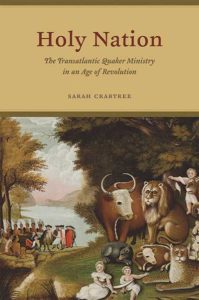Holy Nation: The Transatlantic Quaker Ministry in an Age of Revolution
Reviewed by Cameron McWhirter
September 1, 2016
 By Sarah Crabtree. University of Chicago Press, 2015. 270 pages. $45/hardcover; $10/eBook loan.
By Sarah Crabtree. University of Chicago Press, 2015. 270 pages. $45/hardcover; $10/eBook loan.
Buy from QuakerBooks
In the heady early days of Quakerism, its zealous missionaries spread across the oceans with the growing British Empire, sailing on merchant ships to the American colonies and the Caribbean. George Fox himself preached in Barbados, Jamaica, and the American colonies.
But the religion didn’t dominate anywhere, except for a brief time in the colony of Pennsylvania. Quakerism was, as it always has been, a minority faith, respected in some places, disregarded in others, misunderstood in most.
How would it survive in a diaspora that spread from the cane fields of Jamaica to the crowded cities of France?
Quakerism’s adaptation to the changing world order of the eighteenth and nineteenth centuries is the subject of Sarah Crabtree’s Holy Nation. The book seeks to show how members of the Religious Society of Friends reshaped their institutions and tailored their exhortations to set the faith apart, to make it distinct yet flexible enough to survive during tumultuous times, including the American and French revolutions. Using the metaphor of a holy nation, a Jerusalem for the faithful, Quakers were able to build a truly international faith, despite intense pressures to conform in an age of militant nationalism.
Thomas Clarkson, who worked closely with Quakers to ban the slave trade in England, wrote, “the Quakers differ more than even many foreigners do from their own countrymen.” Quakers stressed their own arcane word choices (such as “thee” and “thou”) and dress (Quaker gray) in an effort to distinguish themselves from those around them. They saw themselves as Quakers first, and citizens of a particular nation second.
“Public Friends endeavored to unite their scattered and besieged followers behind an identity and a theology that transcended worldly divisions,” Crabtree writes.
In the newly formed United States, Quakers resisted patriotic fervor, with critics such as Thomas Paine blasting them as traitors. In the United Kingdom, they carefully resisted nationalist pressure and challenges to their loyalty. In France they were widely praised by intellectuals, though, as Crabtree points out, often their beliefs were distorted by outsiders.
Crabtree does an excellent job of exploring how Quakers developed their own schools, creating curricula that stressed the peace testimony, abolition, and women’s equality. This pedagogy fostered new generations of activists in the United States and the United Kingdom, and helped forge a notion among Quakers of the universality of human spirituality. “Quaker schools placed the Society’s children out of the reach of the homogenizing efforts of the state, encouraging them to identify with their transatlantic counterparts,” she writes. Crabtree has a good command of the balkanizing schisms that wracked the Religious Society in the 1800s, and argues persuasively that pressure from nationalist forces caused the splits.
Holy Nation is an academic work, and unfortunately the prose suffers from excesses common to that genre, including using words like “positionality” and “imbricated.” But if you can get past some turgid sentences, this book presents a thoughtful untangling of a complicated history. It’s a useful addition to our growing understanding of how an odd grouping of stridently peaceful people developed and sustained itself during a turbulent epoch of imperial expansion, industrial transformation, war, and revolution.



Comments on Friendsjournal.org may be used in the Forum of the print magazine and may be edited for length and clarity.